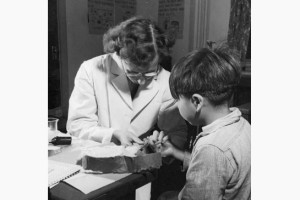The “G” Word: First Nation’s Genocide in the Media

From: Library and Archives Canada, via The Toronto Star.
It’s rare that the Canadian media use the “G” word when talking about the abuses waged on First Nations People of Canada.
Genocide.
I applaud the the Toronto Star for doing so in its column by Phil Fontaine, Dr. Michael Dan, and Bernie M. Farber. It’s time that more and more media outlets took up the practice.
It should be mainstream.
After all, this is very much a modern, present-day story. Take, for example, the Residential Schools. Many of these unquestionably abusive institutions only closed in the 1960’s, 1970’s, and 1980’s. The most recent one closed as recently as 1996 — when I was in university. There are tens of thousands of Residential School survivors in Canada. Many of them are suffering. Hard. So are their families. And that is only one aspect of the impact of attempted genocide on our First Nation’s people.
I’ve had the honour of attending quite a few Elders’ Gatherings, First Nations conferences, sacred gatherings, and Truth and Reconciliation events — often in an official capacity, with camera and notepad to record the moment. The tales I’ve been told sometimes crushed me.
But I’ve also had the joy of being in a remote James Bay Cree community and being embraced by (some of) the community while doing music and puppetry workshops with their children. Apparently goofing around with kids makes you trustworthy, because I saw and was told quite a few stories of how life really is on the “Rez.” I heard of tremendous casualties and tremendous examples of strength.
These events change you.
Well, I suppose I can only truly say that these events changed me. But I’m confident that the feeling would be almost universal.
I honestly don’t believe that much of Canada feels the ramifications of what our government did — what we did — to a diverse country of people. It’s always been tidily hidden away.
But I do believe that constant coverage — and realistically horrific admission — is a big first step in making that feeling more accessible. More understood.
Perhaps it is a means of addressing the abuses that are still happening today.
* * *
From my coverage of the “From Indian Residential Schools to Truth and Reconciliation” conference, May, 2012.
“I visited the community of Mishkeegogamang, a half-hour south of Pickle Lake,” he recalled. “What struck me was the number of fresh graves. And on these graves – and in the cemeteries – you saw all of these baseball caps, dolls, toys… I talked to the chief and he said that they had lost something close to 200 people from violent deaths over the past decade. And he told me that everyone hated themselves – particularly the kids.”
“You see these brand new houses – and the windows are smashed, the furniture destroyed. They hate themselves. They hate their houses. They burn down the school. The chief tells me it is because they have no hope. There is no hope.”

One thought on “The “G” Word: First Nation’s Genocide in the Media”
Comments are closed.